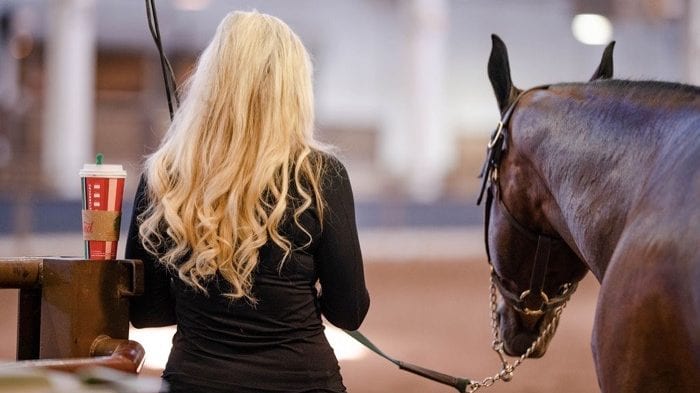Horse shows. Our favorite way to spend a week. Everyone loves them, but they can get stressful from time-to-time. One of the essential things to keep stress to a minimum is figuring out a routine that works for you and your horse. Finding a method allows your horse to get in a working mindset and perform to their maximum potential.
“Routines let the horse know what to expect,” Tami McAllister, of Rolling M Ranch, said. If you repeat the same process, or close to the same process, at every show, your horse will understand when to stop goofing around and get into show mode.
It allows you to get in a showing mindset as well, and maybe even calm your nerves. “I think it helps the riders as much as the horses,” Dawn Baker, of Baker Futurity Horses, said. “They feel their horses are ready and have one more chance to play.”
So, how can you build your personal show routine?
 Having your horse show ring ready
Having your horse show ring ready
Anything from longing, to doing some groundwork, or stretching exercises can work. “Our warm-ups at shows are not much different than our routine rides,” Baker said. “We do a little more lunging to prepare for the show pen.” Warm-up is one of the essential parts of your routine. Whether your method is as little as 15 minutes of lunging, or stretching your horse and riding every morning, it can make a huge difference in how your horse performs throughout the day.
Shaping your routine to you
You could walk around the venue, have an early morning warm-up ride in the main ring, or take the time for a great long grooming session. Some people have a “pregame” playlist or a pep talk from their trainer. The most important thing about your routine is that it helps you. Something might work for someone else, and not work for you. Try different things until you find what fits.
Leaving time to fix problems
If your horse woke up on the wrong side of the stall that morning, you’re going to want to have time to adjust their attitude and get them focused. “I just try and make sure my clients feel good and ready,” Baker said. “I do a test ride to make sure the horses feel the same. I also make sure there is time for adjustments.” That extra time for schooling and fixes is crucial at shows, so make sure you build it into your routine.
Another piece to the puzzle: versatility. “I try to be flexible,” McAllister said, “because you never know what time you’re going to be showing.” As everyone knows, every show and every day is different. You could be jogging into the show pen at 8 in the morning, or 11 p.m. Equestrians have to be able to adapt, because horses are unpredictable, as are horse shows. Your routine should be flexible and ready to change to any time of day or any show.
Putting the horse first, always
“A typical day at a horse show starts early,” McAllister said. “We start the day by feeding, cleaning stalls, and watering the horses. Our priority is taking care of them. Then we start preparing for the day’s show.” It’s easy to get caught up in the chaos of a horse show and focus on the competition, but at the end of the day, horses are living, breathing animals that allow us to be their partner. If they didn’t want us on their backs, they could get us off it pretty quickly. Part of your horse show routine should be taking a moment to focus on your horse, making sure they’re comfortable and healthy, and even bonding with them. This is where 10 minutes of thorough grooming, cuddling, or pre-show treats could come in.
Make sure you are the person preparing your horse
A big part of showing is working with your horse, as well as their moods. “At the big shows, I like to prep my horses,” McAllister said, “so that I know how they are that day.” You should be the one to get them ready and warm them up, so you can figure out how they’re feeling. If they’re in a good mood that day, great. If not, you’re the one who has to pilot them through a class eventually, so why not figure it out in the warm-up pen.
All in all, routines at shows are important for excellent performance, from both you and your horse. Use these pointers to create a routine that works for your team. This will put stress at bay, and make room for success in the show pen.








